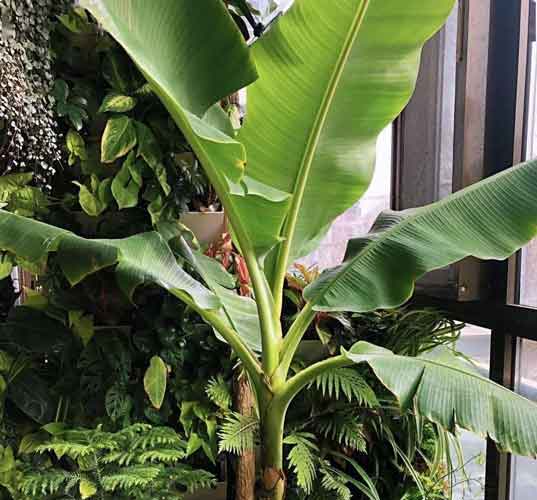Banana Tree (Plantain Tree) Profile
Written by Iris
Oct 09 2021
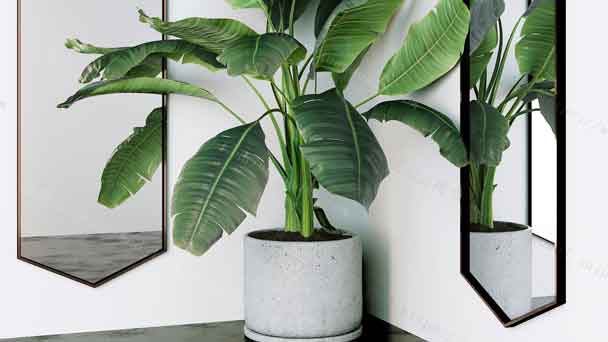
Banana Tree (plantain tree) produce large, elegant leaves and an occasional bunch of fruit that certainly lends gravitas to any garden or greenhouse. Although Banana Tree (plantain tree) are delicate plants, some species are hardy and can leave the outdoors in winter, especially in the milder parts of the UK, so it's worth experimenting in the garden.
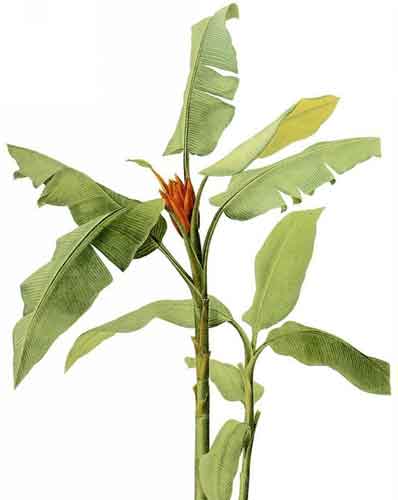
Sow individually, 1cm (3/8in) deep, in pots of seed compost. Place in a warm location, at a temperature of 21-24ºC (70-75ºF). Germination of fresh seed is quick, but older seed can take up to six months
Gradually move seedlings into more light and increase watering and feeding to encourage growth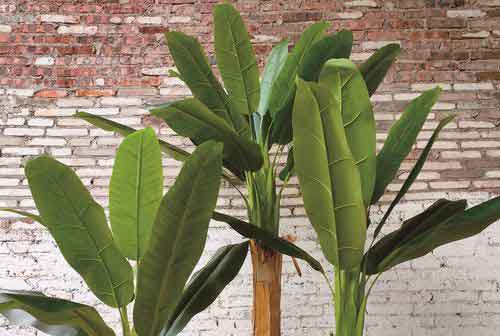
Musa basjoo AGM: Often grown permanently outdoors in sheltered gardens in milder parts of the country, although it has been known to survive in sheltered northerly gardens.
Musa × paradisiaca ‘Rajapuri’: Deep green leaves and may produce edible fruits. Quite hardy and wind-resistant.
Musa sikkimensis: Bronze markings on the young leaves and trunk. The foliage is fairly wind-resistant.
Musa acuminata ‘Dwarf Cavendish’ AGM: Large leaves, sometimes marked red.
Musa acuminata ‘Zebrina’ AGM: Grown for its red-striped foliage. Suitable for container cultivation.
Musa balbisiana: Attractive bluish-green leaves.
Musa itinerans ‘Yunnan’: Slender stems and wide arching, blue-green leaves.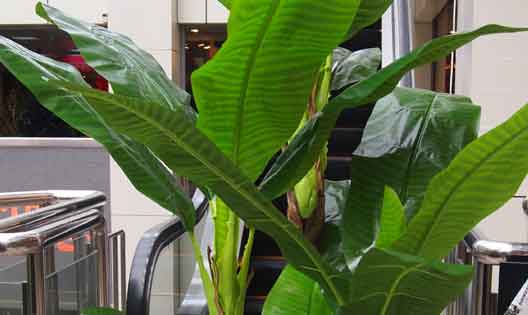
Aphids: These pests cause curled and shriveled foliage and can also transmit other diseases that will affect any fruit produced.
Black weevils: If you see jelly-like sap oozing from the plant, you may have black weevils that can be eliminated with pesticides.
Nematodes: This is the banana tree's most common pest that will rot the plant and fruit.
Sap-sucking insects: Mealybugs and red spider mites are also common to banana trees.
Scarring beetle: This pest invades bunches of the plant's fruit and can be eliminated with pesticide.
Thrips: This pest will stain and split the peel of the plant's fruit.
There are many diseases common to banana trees in large orchards and are taken care of with commercial fungicides and pesticides. As for indoor potted banana trees, be on the lookout for root rot, leaf-spot disease, wilt, and powdery mildew.
Lemongrass: A natural pest deterrent, this aromatic culinary herb will keep annoying bugs at bay, while also helping to block weeds from forming.
Banana Tree (Plantain Tree) PictureBanana Tree (Plantain Tree) InfoBanana Tree (plantain tree) HistoryBanana Tree (Plantain Tree) Distribution AreaHow to Grow and Care for Banana Tree (Plantain Tree)How to Grow Banana Tree (Plantain Tree)How to Care for Banana Tree (Plantain Tree)Uses of Banana Tree (Plantain Tree)Varieties of Banana Tree (Plantain Tree)Banana Tree (Plantain Tree) Common Pests/DiseasesBanana Tree (Plantain Tree) Companion Plants
Banana Tree (Plantain Tree) Picture
Banana Tree (Plantain Tree) Info
| Common Names | Banana tree, plantain tree |
| Botanical Name | Musa spp. |
| Family | Musaceae |
| Plant Type | Herbaceous, perennial |
| Mature Size | 2–30 ft. tall, 1–15 ft. wide (varies widely by species) |
| Sun Exposure | Full |
| Soil Type | Loamy, well-drained |
| Soil pH | Acidic |
Banana Tree (plantain tree) History
Banana trees have been cultivated for thousands of years and their origin seems to be the Malaysian peninsula, New Guinea, and Southeast Asia. Banana trees can reach a height of 7 to 30 feet, depending on many factors such as variety, amount of sun, soil, and overall climate. In fact, Banana trees are a hybrid of two species of banana: Musa acuminata and Musa balbisiana.Banana Tree (Plantain Tree) Distribution Area
Bananas and other tropical fruit like pineapples are grown in the tropical regions of Africa, Latin America, the Caribbean, and the Pacific. Most tropical fruit available in British supermarkets is exported from Latin America, the Caribbean and West Africa.
How to Grow and Care for Banana Tree (Plantain Tree)
How to Grow Banana Tree (Plantain Tree)
- With Seeds
Sow individually, 1cm (3/8in) deep, in pots of seed compost. Place in a warm location, at a temperature of 21-24ºC (70-75ºF). Germination of fresh seed is quick, but older seed can take up to six months
Gradually move seedlings into more light and increase watering and feeding to encourage growth
- With Corms
- With Division
How to Care for Banana Tree (Plantain Tree)
- Light Care
- Soil Care
- Water Care
- Temperature and Humidity
- Fertilizer Care
- Pruning Care

Uses of Banana Tree (Plantain Tree)
Banana trees are eaten as a vegetable and are cooked prior to consumption. Banana trees are an important component of many dishes in Western Africa and Caribbean countries. In addition, the leaves of Musa species can be used as a source of fibre for thread, cloth string, thread or can be used as thatch and roofing. The Banana trees are also grown as an effective source of shade for other crops.Varieties of Banana Tree (Plantain Tree)
Ensete ventricosum AGM: Can be grown outdoors in frost-free areas. Erect, narrowly oblong leaves to 3m in length, with red midrib beneath.Musa basjoo AGM: Often grown permanently outdoors in sheltered gardens in milder parts of the country, although it has been known to survive in sheltered northerly gardens.
Musa × paradisiaca ‘Rajapuri’: Deep green leaves and may produce edible fruits. Quite hardy and wind-resistant.
Musa sikkimensis: Bronze markings on the young leaves and trunk. The foliage is fairly wind-resistant.
Musa acuminata ‘Dwarf Cavendish’ AGM: Large leaves, sometimes marked red.
Musa acuminata ‘Zebrina’ AGM: Grown for its red-striped foliage. Suitable for container cultivation.
Musa balbisiana: Attractive bluish-green leaves.
Musa itinerans ‘Yunnan’: Slender stems and wide arching, blue-green leaves.

Banana Tree (Plantain Tree) Common Pests/Diseases
Owners of banana trees need to stay vigilant of the many pests and diseases that can afflict a banana tree. Pests include the following:Aphids: These pests cause curled and shriveled foliage and can also transmit other diseases that will affect any fruit produced.
Black weevils: If you see jelly-like sap oozing from the plant, you may have black weevils that can be eliminated with pesticides.
Nematodes: This is the banana tree's most common pest that will rot the plant and fruit.
Sap-sucking insects: Mealybugs and red spider mites are also common to banana trees.
Scarring beetle: This pest invades bunches of the plant's fruit and can be eliminated with pesticide.
Thrips: This pest will stain and split the peel of the plant's fruit.
There are many diseases common to banana trees in large orchards and are taken care of with commercial fungicides and pesticides. As for indoor potted banana trees, be on the lookout for root rot, leaf-spot disease, wilt, and powdery mildew.
Banana Tree (Plantain Tree) Companion Plants
Sweet Potatoes: These low-growing root vegetables provide a leafy ground cover that shields the soil, helping to prevent weeds and retain moisture.Lemongrass: A natural pest deterrent, this aromatic culinary herb will keep annoying bugs at bay, while also helping to block weeds from forming.
Latest Updated
- Benefits of Bugleweed - 7 Science-backed Health Benefits
- Bugleweed Dangers & Side Effects - Is It Poisonous?
- How to Plant Evergreen Trees - What You Should Know
- When to Plant Evergreens - Grow Guide for Evergreen Trees
- 12 Wonderful Evergreen Shrubs for Your Garden
- 12 Popular Evergreen Plants with Pictures for Beginners
- When And How To Prune A Lilac Bush Like a Pro
- How to Grow & Care for Lilac Vine (Hardenbergia Violacea)
- Japanese Lilac Tree (Syringa Reticulata) Care & Propagation Guide
- Shumard Oak Pros and Cons - What to Know
Popular Articles
- Winter maintenance of Antirrhinum Majus
- How to Grow Terminalia Mantaly Tree
- How to Grow and Care for Crossostephium Chinense
- How to grow Antirrhinum Majus in spring
- Peristeria Elata (Dove Orchid) Profile: Info & Care Guide
- Underwatered Snake Plant (Sansevieria Trifasciata) - Signs And How To Fix
- How to Care for Brazilian Jasmine Plant (Mandevilla Sanderi)
- How to Grow & Care for Graptopetalum Purple Delight in Summer
- Rosa Chinensis (China Rose): Plant Growing & Care Tips
- How to Care for Baby Sun Rose (Aptenia Cordifolia)
